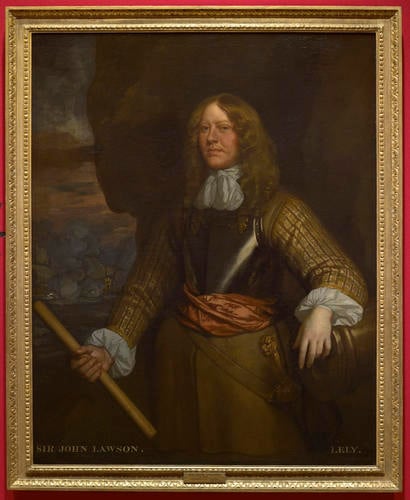-
1 of 253523 objects
Sir John Lawson (d. 1665) c.1665-71
Oil on canvas | 127.6 x 102.2 cm (support, canvas/panel/stretcher external) | RCIN 405153
-
This portrait was one of a set of thirteen portraits commissioned by the Duke of York, the Lord High Admiral of the Fleet, following the naval victory over the Dutch at the battle of Lowestoft on 18 June 1665. Hostilities with Holland led to the outbreak of the Second Anglo-Dutch War in 1665. After an unsuccessful blockade of Dutch ports in May, a fleet of a hundred ships, led by the Duke of York in his flagship the Royal Charles, engaged with the Dutch fleet off the coast of Lowestoft in Suffolk.
John Lawson was a distinguished naval officer (indicated by the sea battle visible in the distance) with anabaptist and republican opinions who had held commands at sea for the parliamentarian side since 1642, but supported the Restoration and won the favour of both Charles II and the Duke of York.
He wears the buff coat, breastplate and sash typically worn by military men in portraits of this period. As warfare became more focused on gunpowder during the seventeenth century, buff coats developed as a popular form of military attire for both Parliamentarian and Royalist cavalrymen and officers. They were lighter than full armour, yet still provided protection against blades and sometimes musket shot, particularly when combined with a breastplate as seen here. Coloured silk sashes were worn as a mark of rank and to identify members of different regiments in the confusing, smoke-filled battlefield. John Lawson wears a bright red sash indicative of his royalist persuasion by this date. He carries a baton of command in one hand while leaning his other arm on a cannon. Lawson was mortally wounded during the battle of Lowestoft and if this portrait was painted from life, it must have been whilst he was suffering from the injury which would eventually kill him. Alternatively it might have been commissioned as a posthumous tribute.
Only two of the set remain in the Royal Collection - this and RCIN 405883, the rest having been presented by George IV in 1824 to Greenwich Hospital. They are now in the collection of Royal Museums Greenwich.
Text adapted from Charles II: Art and Power, London, 2017.Provenance
Part of a set of thirteen naval portraits painted for James II when Duke of York; in store at St James's Palace in 1688 (nos 1201-10); in the King's Eating Room below stairs at Windsor Castle in 1710 (no 180); listed among paintings at Windsor 'standing down' in 1776; in the Gallery, later called 'Admirals Gallery below stairs', at Windsor in 1792; two versions of the painting are listed at Windsor in 1813 and 1816, one - the version in the National Maritime Museum (2833) - in the Admiral's Gallery, and this one in the King's Private Bedchamber at Hampton Court.
-
Creator(s)
Commissioner(s)
Subject(s)
-
Medium and techniques
Oil on canvas
Measurements
127.6 x 102.2 cm (support, canvas/panel/stretcher external)
140.8 x 115.1 x 4.1 cm (frame, external)
Category
Object type(s)

